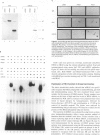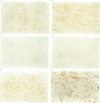Abstract
A variant form of the human oestrogen receptor (ER) mRNA lacking sequences encoded within exon 5 has been described (Fuqua SAW, Fitzgerald SD, Chamness GC, Tandon AK, McDonnell DP, Nawaz Z, O'Malloy BW, McGuire WL 1991, Cancer Res 51: 105-109). We have examined the expression of the exon 5-deleted ER (HE delta5) mRNA variant in breast biopsies using reverse transcriptase polymerase chain reaction (RT - PCR). HE delta5 mRNA was present in only 13% of non-malignant breast tissues compared with 32% of carcinomas (95% CI, P=0.05). Presence of the HE delta5 mRNA was associated with the presence of immunohistochemically detected ER (P=0.015) and progesterone receptor (PR) (P=0.02). There was a positive correlation between the presence of HE delta5 and disease-free survival (P=0.05), suggesting that the presence of HE delta5 may be an indicator of better prognosis. We have raised a monoclonal antibody specific to the C-terminal amino acids of HE delta5. This antibody recognized the variant but not the wild-type ER protein. We show that HE delta5 protein is present in breast cancer using immunohistochemical techniques. We also analysed trans-activation by HE delta5 in mammalian cells and showed that, in MCF-7 cells, HE delta5 competes with wild-type ER to inhibit ERE-dependent trans-activation. Our results indicate that this variant is unlikely to be responsible for endocrine resistance of breast cancer, but its presence at both the mRNA and protein level suggest that it may, nevertheless, be involved in regulating the expression of oestrogen-responsive genes in breast cancer.
Full text
PDF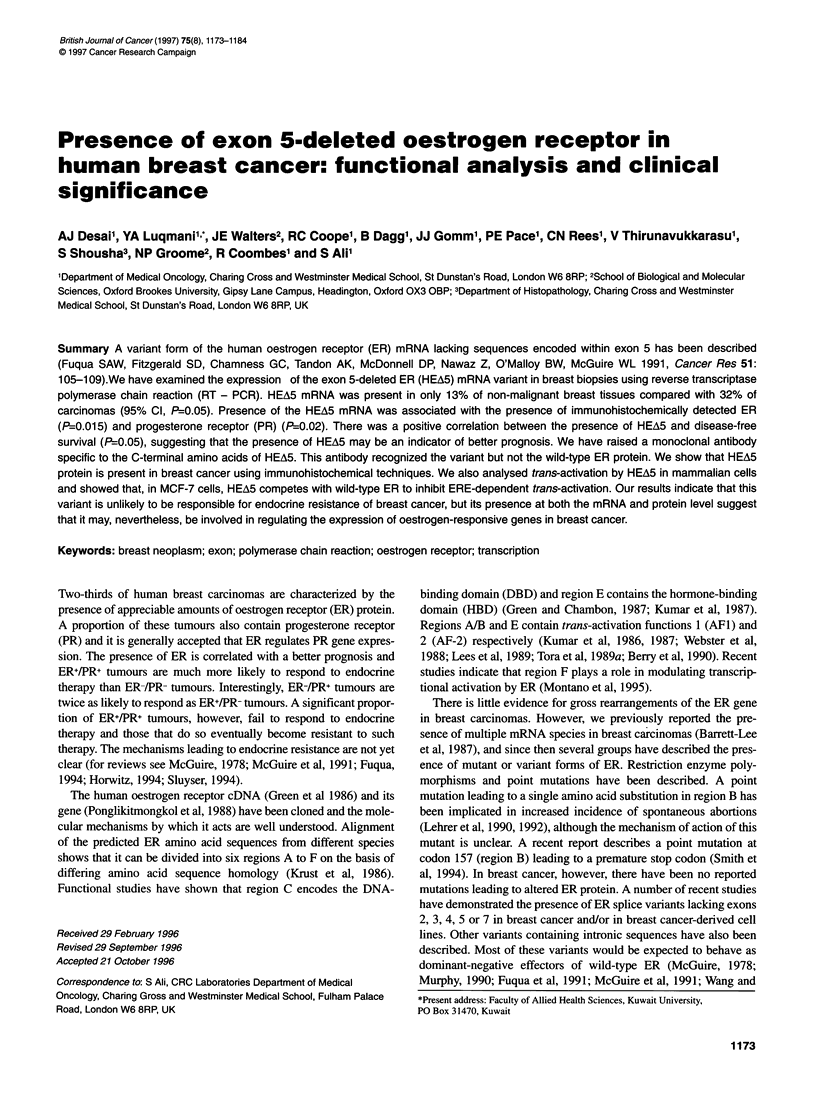
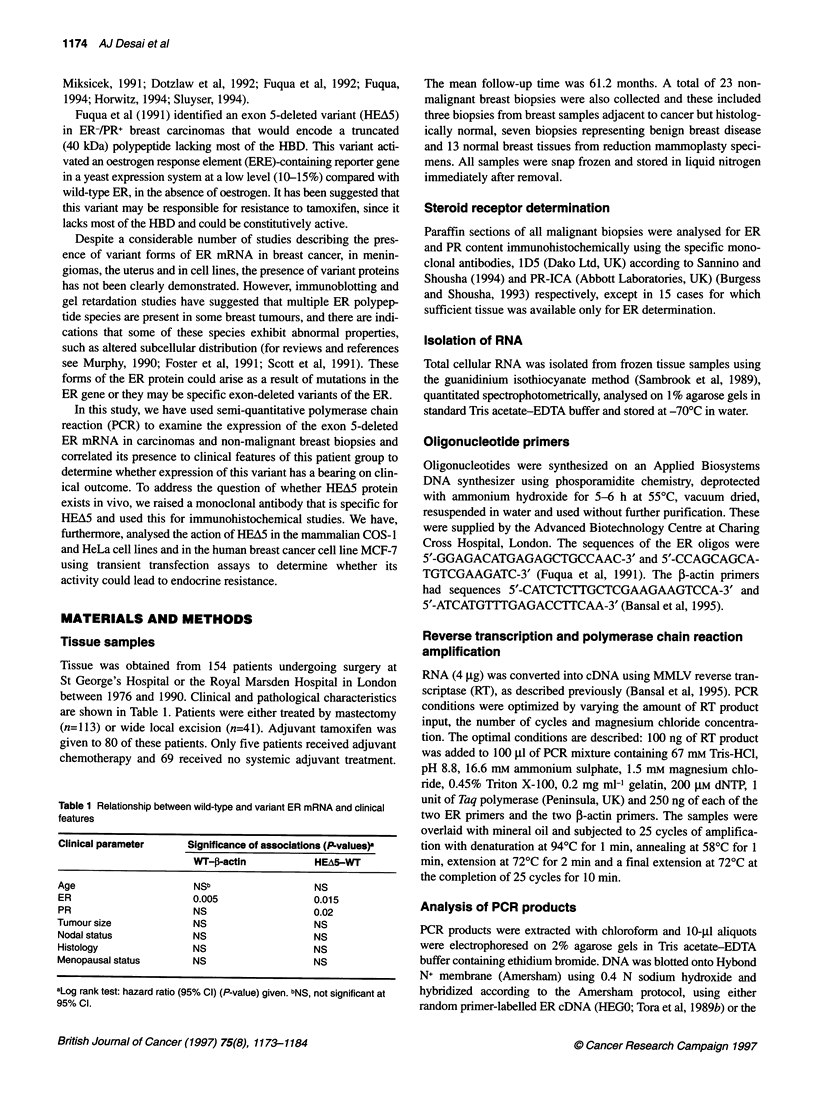

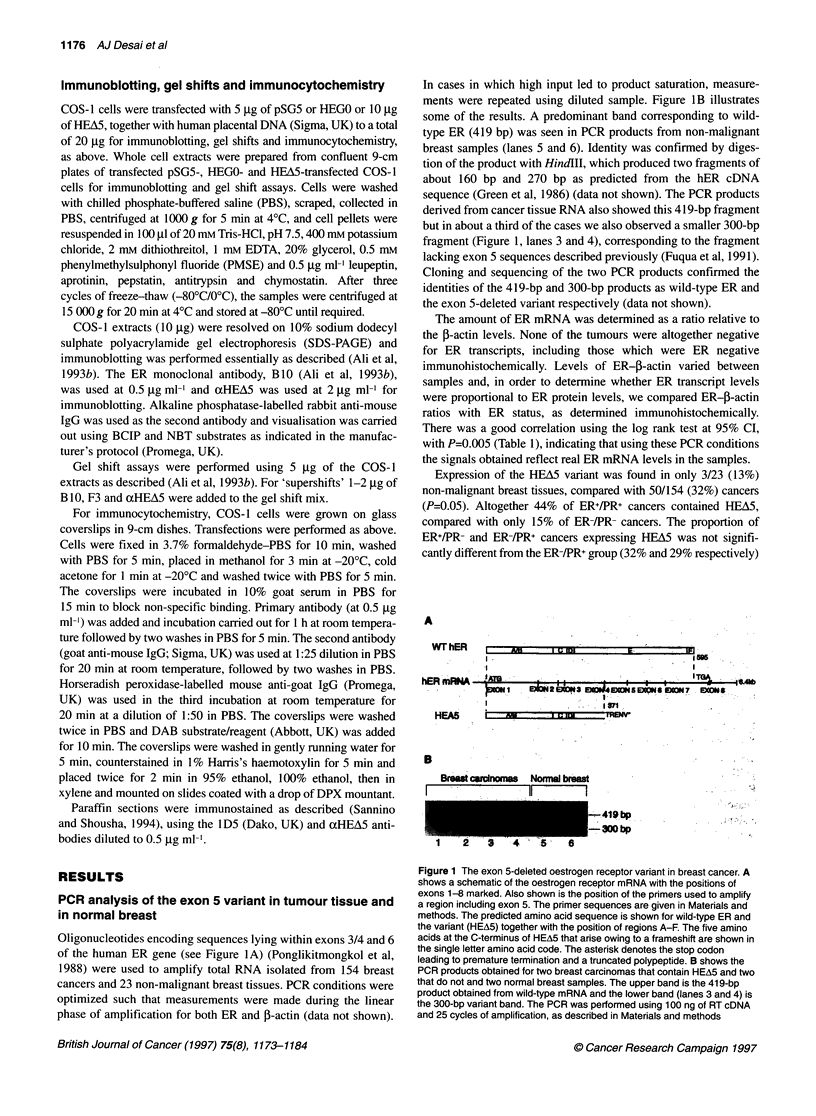
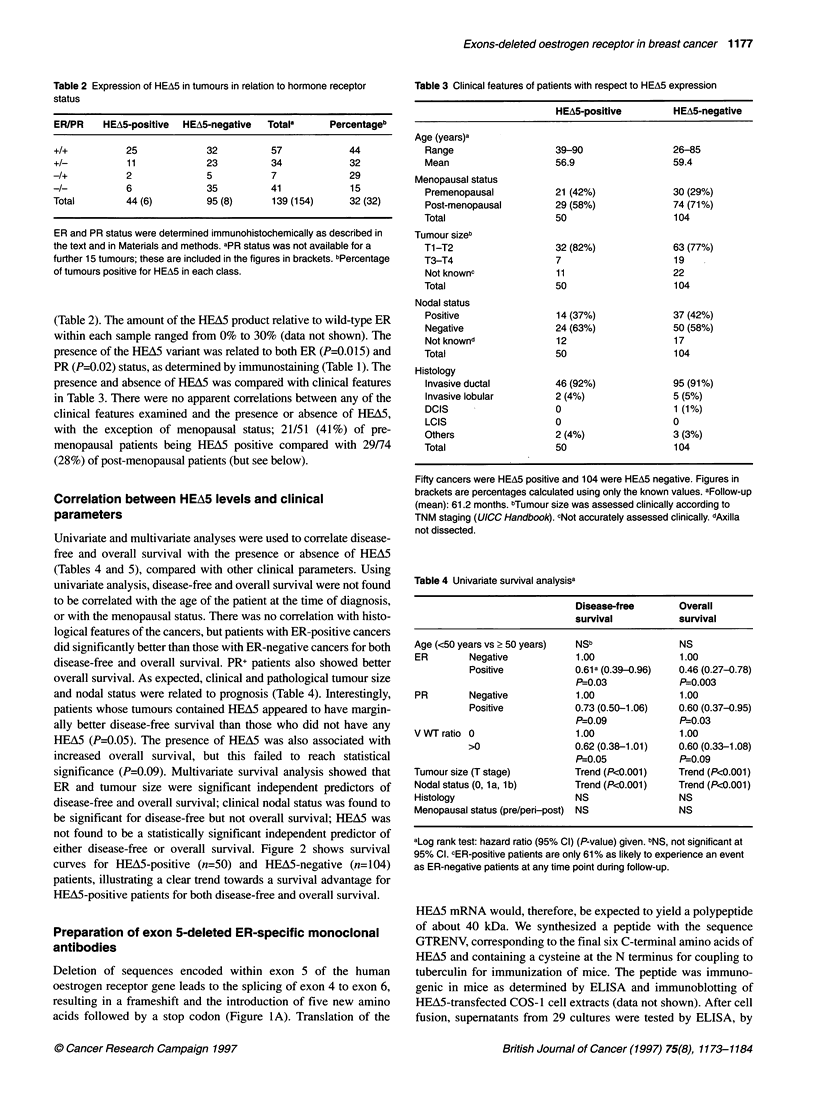

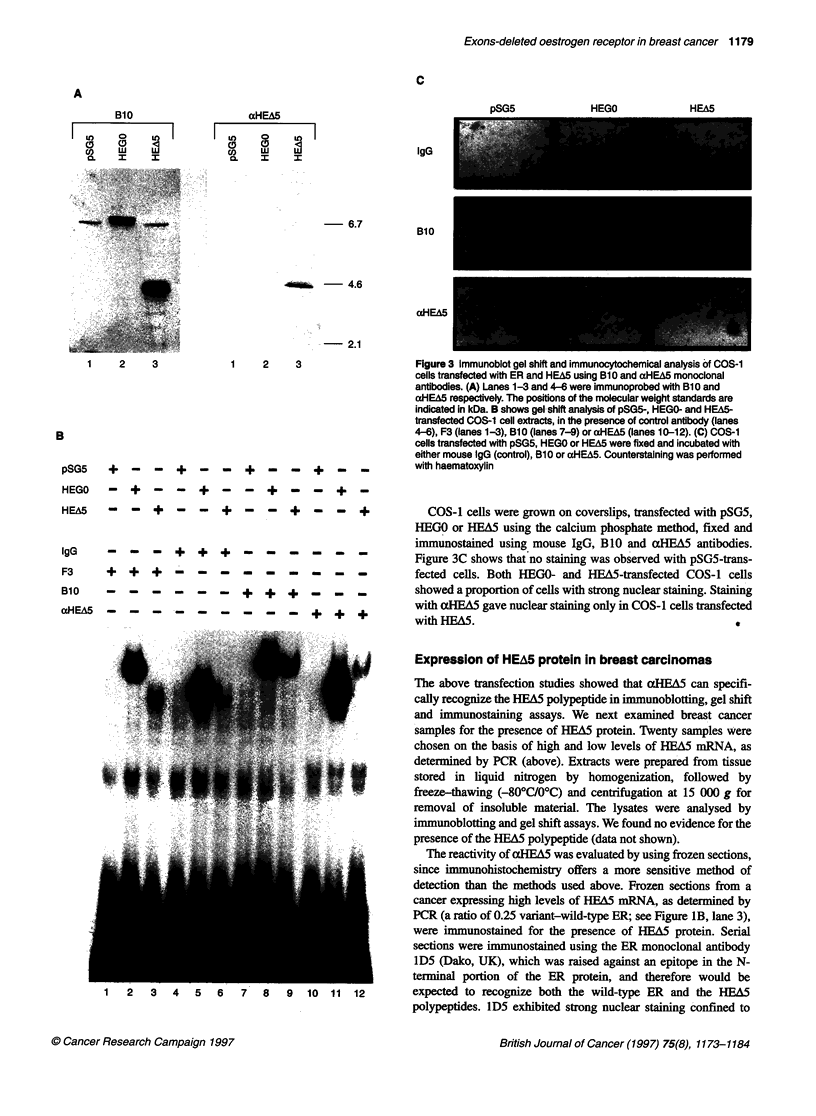
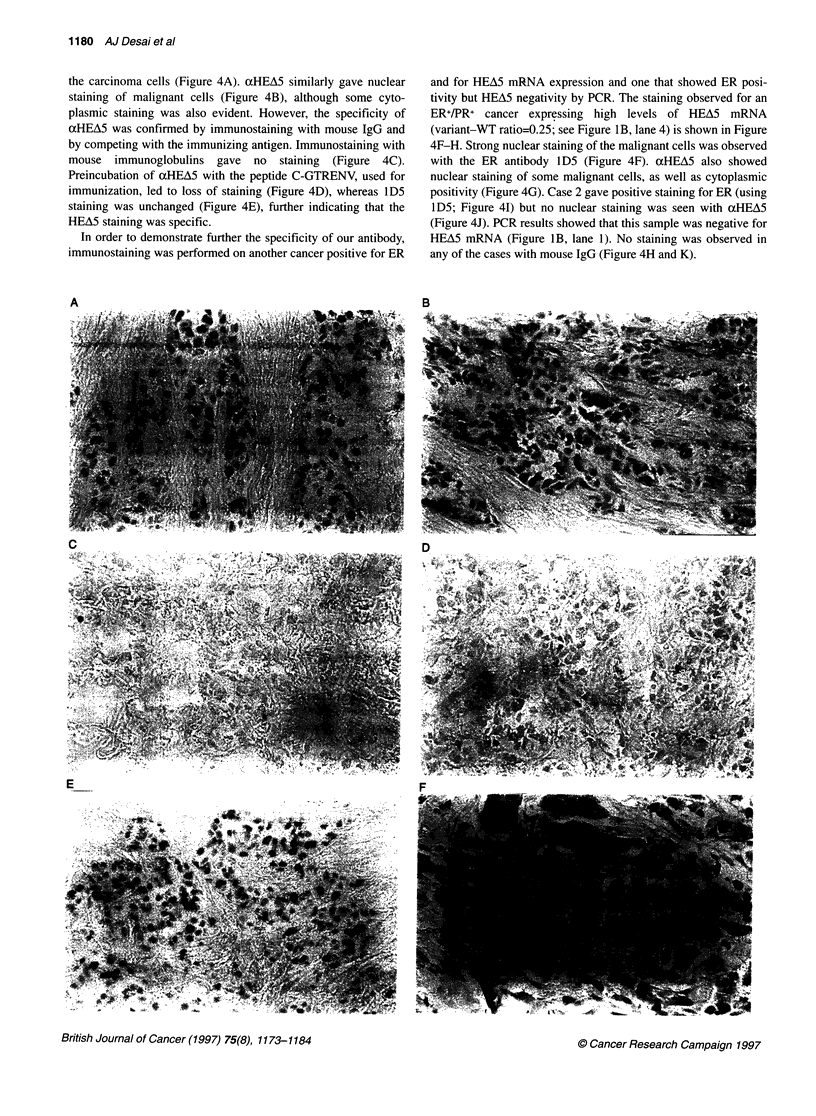

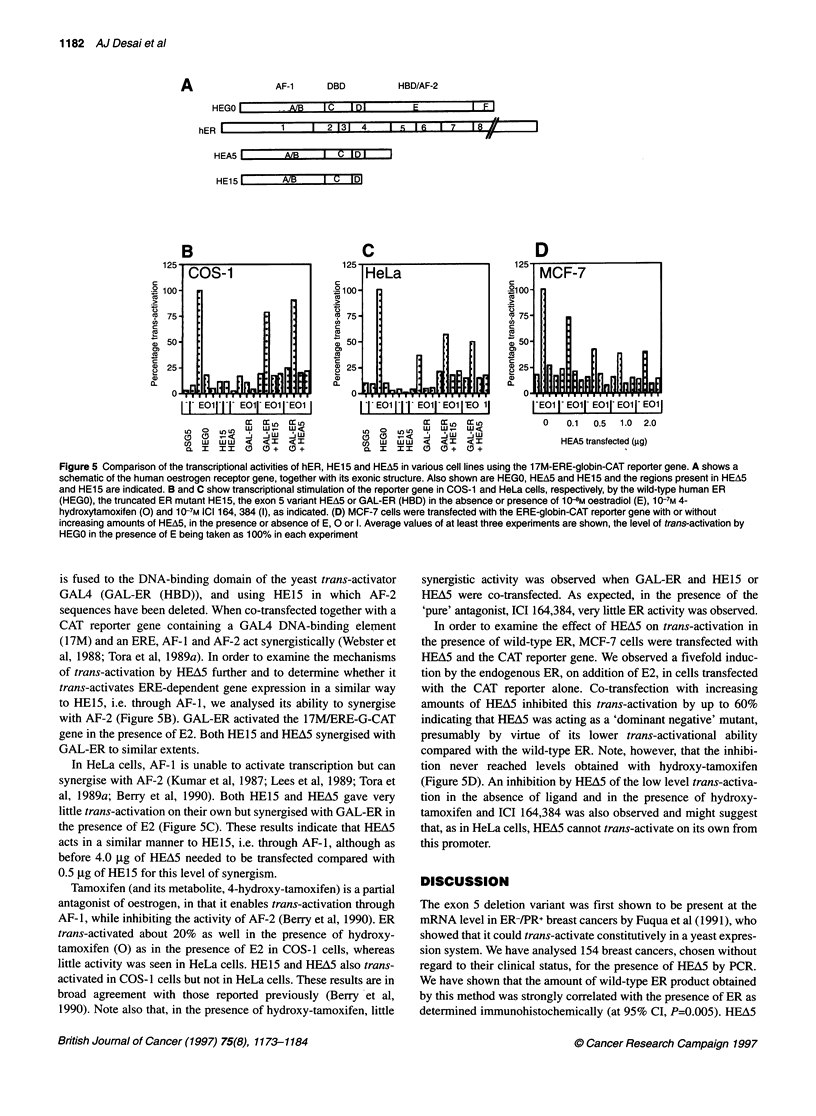
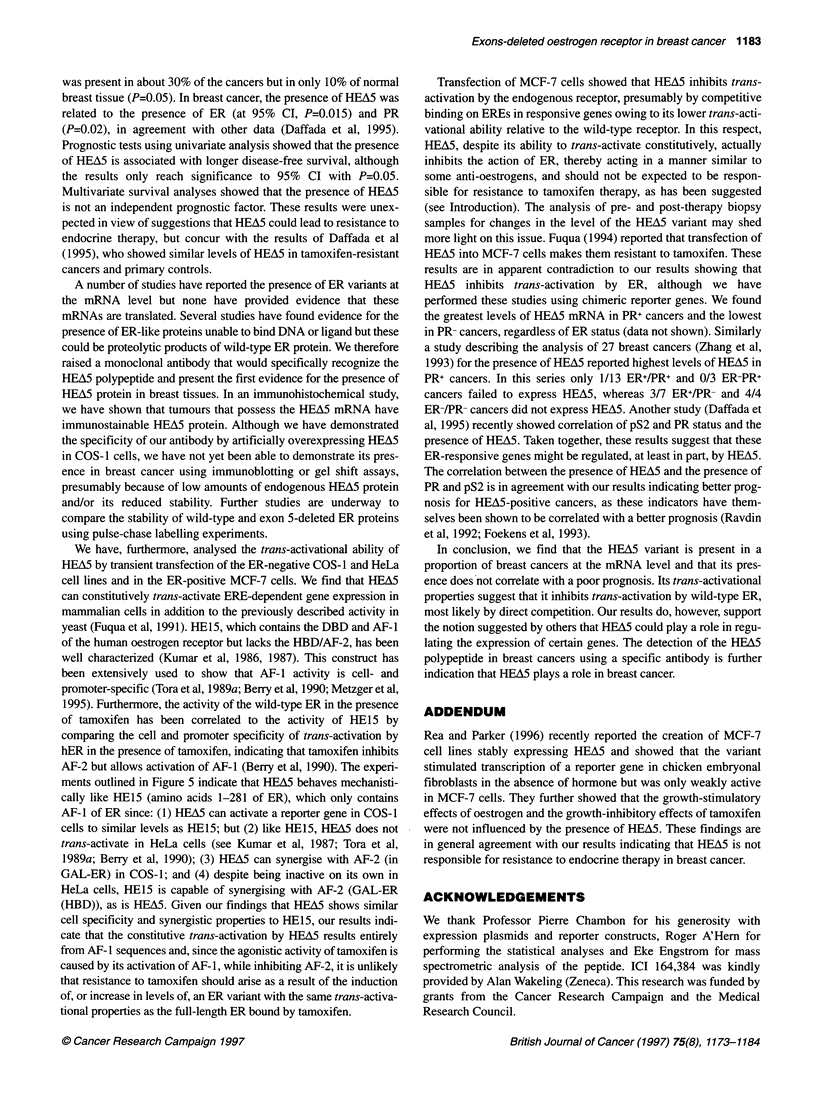
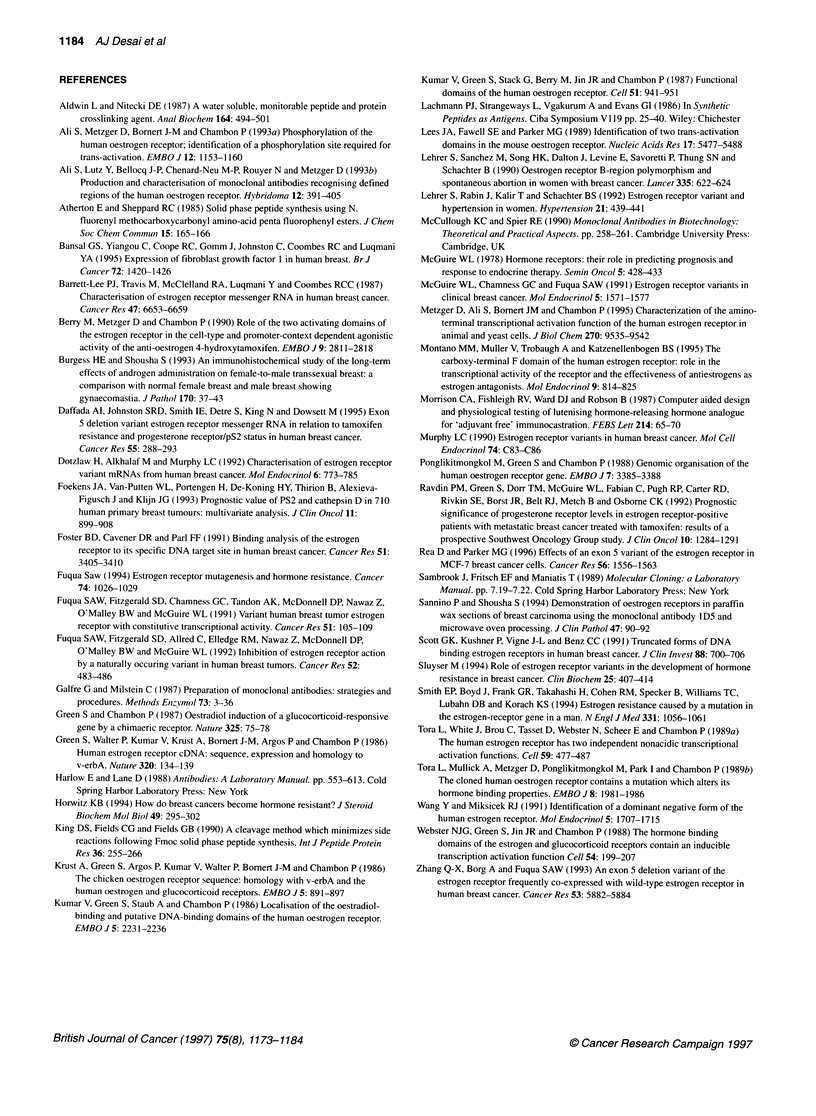
Images in this article
Selected References
These references are in PubMed. This may not be the complete list of references from this article.
- Aldwin L., Nitecki D. E. A water-soluble, monitorable peptide and protein crosslinking agent. Anal Biochem. 1987 Aug 1;164(2):494–501. doi: 10.1016/0003-2697(87)90524-0. [DOI] [PubMed] [Google Scholar]
- Ali S., Lutz Y., Bellocq J. P., Chenard-Neu M. P., Rouyer N., Metzger D. Production and characterization of monoclonal antibodies recognising defined regions of the human oestrogen receptor. Hybridoma. 1993 Aug;12(4):391–405. doi: 10.1089/hyb.1993.12.391. [DOI] [PubMed] [Google Scholar]
- Barrett-Lee P. J., Travers M. T., McClelland R. A., Luqmani Y., Coombes R. C. Characterization of estrogen receptor messenger RNA in human breast cancer. Cancer Res. 1987 Dec 15;47(24 Pt 1):6653–6659. [PubMed] [Google Scholar]
- Berry M., Metzger D., Chambon P. Role of the two activating domains of the oestrogen receptor in the cell-type and promoter-context dependent agonistic activity of the anti-oestrogen 4-hydroxytamoxifen. EMBO J. 1990 Sep;9(9):2811–2818. doi: 10.1002/j.1460-2075.1990.tb07469.x. [DOI] [PMC free article] [PubMed] [Google Scholar]
- Burgess H. E., Shousha S. An immunohistochemical study of the long-term effects of androgen administration on female-to-male transsexual breast: a comparison with normal female breast and male breast showing gynaecomastia. J Pathol. 1993 May;170(1):37–43. doi: 10.1002/path.1711700107. [DOI] [PubMed] [Google Scholar]
- Daffada A. A., Johnston S. R., Smith I. E., Detre S., King N., Dowsett M. Exon 5 deletion variant estrogen receptor messenger RNA expression in relation to tamoxifen resistance and progesterone receptor/pS2 status in human breast cancer. Cancer Res. 1995 Jan 15;55(2):288–293. [PubMed] [Google Scholar]
- Dotzlaw H., Alkhalaf M., Murphy L. C. Characterization of estrogen receptor variant mRNAs from human breast cancers. Mol Endocrinol. 1992 May;6(5):773–785. doi: 10.1210/mend.6.5.1603086. [DOI] [PubMed] [Google Scholar]
- Foekens J. A., van Putten W. L., Portengen H., de Koning H. Y., Thirion B., Alexieva-Figusch J., Klijn J. G. Prognostic value of PS2 and cathepsin D in 710 human primary breast tumors: multivariate analysis. J Clin Oncol. 1993 May;11(5):899–908. doi: 10.1200/JCO.1993.11.5.899. [DOI] [PubMed] [Google Scholar]
- Foster B. D., Cavener D. R., Parl F. F. Binding analysis of the estrogen receptor to its specific DNA target site in human breast cancer. Cancer Res. 1991 Jul 1;51(13):3405–3410. [PubMed] [Google Scholar]
- Fuqua S. A. Estrogen receptor mutagenesis and hormone resistance. Cancer. 1994 Aug 1;74(3 Suppl):1026–1029. doi: 10.1002/1097-0142(19940801)74:3+<1026::aid-cncr2820741509>3.0.co;2-k. [DOI] [PubMed] [Google Scholar]
- Fuqua S. A., Fitzgerald S. D., Allred D. C., Elledge R. M., Nawaz Z., McDonnell D. P., O'Malley B. W., Greene G. L., McGuire W. L. Inhibition of estrogen receptor action by a naturally occurring variant in human breast tumors. Cancer Res. 1992 Jan 15;52(2):483–486. [PubMed] [Google Scholar]
- Fuqua S. A., Fitzgerald S. D., Chamness G. C., Tandon A. K., McDonnell D. P., Nawaz Z., O'Malley B. W., McGuire W. L. Variant human breast tumor estrogen receptor with constitutive transcriptional activity. Cancer Res. 1991 Jan 1;51(1):105–109. [PubMed] [Google Scholar]
- Green S., Chambon P. Oestradiol induction of a glucocorticoid-responsive gene by a chimaeric receptor. Nature. 1987 Jan 1;325(6099):75–78. doi: 10.1038/325075a0. [DOI] [PubMed] [Google Scholar]
- Green S., Walter P., Kumar V., Krust A., Bornert J. M., Argos P., Chambon P. Human oestrogen receptor cDNA: sequence, expression and homology to v-erb-A. Nature. 1986 Mar 13;320(6058):134–139. doi: 10.1038/320134a0. [DOI] [PubMed] [Google Scholar]
- Horwitz K. B. How do breast cancers become hormone resistant? J Steroid Biochem Mol Biol. 1994 Jun;49(4-6):295–302. doi: 10.1016/0960-0760(94)90271-2. [DOI] [PubMed] [Google Scholar]
- King D. S., Fields C. G., Fields G. B. A cleavage method which minimizes side reactions following Fmoc solid phase peptide synthesis. Int J Pept Protein Res. 1990 Sep;36(3):255–266. doi: 10.1111/j.1399-3011.1990.tb00976.x. [DOI] [PubMed] [Google Scholar]
- Krust A., Green S., Argos P., Kumar V., Walter P., Bornert J. M., Chambon P. The chicken oestrogen receptor sequence: homology with v-erbA and the human oestrogen and glucocorticoid receptors. EMBO J. 1986 May;5(5):891–897. doi: 10.1002/j.1460-2075.1986.tb04300.x. [DOI] [PMC free article] [PubMed] [Google Scholar]
- Kumar V., Green S., Stack G., Berry M., Jin J. R., Chambon P. Functional domains of the human estrogen receptor. Cell. 1987 Dec 24;51(6):941–951. doi: 10.1016/0092-8674(87)90581-2. [DOI] [PubMed] [Google Scholar]
- Kumar V., Green S., Staub A., Chambon P. Localisation of the oestradiol-binding and putative DNA-binding domains of the human oestrogen receptor. EMBO J. 1986 Sep;5(9):2231–2236. doi: 10.1002/j.1460-2075.1986.tb04489.x. [DOI] [PMC free article] [PubMed] [Google Scholar]
- Lees J. A., Fawell S. E., Parker M. G. Identification of two transactivation domains in the mouse oestrogen receptor. Nucleic Acids Res. 1989 Jul 25;17(14):5477–5488. doi: 10.1093/nar/17.14.5477. [DOI] [PMC free article] [PubMed] [Google Scholar]
- Lehrer S., Rabin J., Kalir T., Schachter B. S. Estrogen receptor variant and hypertension in women. Hypertension. 1993 Apr;21(4):439–441. doi: 10.1161/01.hyp.21.4.439. [DOI] [PubMed] [Google Scholar]
- Lehrer S., Sanchez M., Song H. K., Dalton J., Levine E., Savoretti P., Thung S. N., Schachter B. Oestrogen receptor B-region polymorphism and spontaneous abortion in women with breast cancer. Lancet. 1990 Mar 17;335(8690):622–624. doi: 10.1016/0140-6736(90)90410-7. [DOI] [PubMed] [Google Scholar]
- McGuire W. L., Chamness G. C., Fuqua S. A. Estrogen receptor variants in clinical breast cancer. Mol Endocrinol. 1991 Nov;5(11):1571–1577. doi: 10.1210/mend-5-11-1571. [DOI] [PubMed] [Google Scholar]
- McGuire W. L. Hormone receptors: their role in predicting prognosis and response to endocrine therapy. Semin Oncol. 1978 Dec;5(4):428–433. [PubMed] [Google Scholar]
- Metzger D., Ali S., Bornert J. M., Chambon P. Characterization of the amino-terminal transcriptional activation function of the human estrogen receptor in animal and yeast cells. J Biol Chem. 1995 Apr 21;270(16):9535–9542. doi: 10.1074/jbc.270.16.9535. [DOI] [PubMed] [Google Scholar]
- Montano M. M., Müller V., Trobaugh A., Katzenellenbogen B. S. The carboxy-terminal F domain of the human estrogen receptor: role in the transcriptional activity of the receptor and the effectiveness of antiestrogens as estrogen antagonists. Mol Endocrinol. 1995 Jul;9(7):814–825. doi: 10.1210/mend.9.7.7476965. [DOI] [PubMed] [Google Scholar]
- Morrison C. A., Fishleigh R. V., Ward D. J., Robson B. Computer-aided design and physiological testing of a luteinising hormone-releasing hormone analogue for 'adjuvant-free' immunocastration. FEBS Lett. 1987 Apr 6;214(1):65–70. doi: 10.1016/0014-5793(87)80014-5. [DOI] [PubMed] [Google Scholar]
- Murphy L. C. Estrogen receptor variants in human breast cancer. Mol Cell Endocrinol. 1990 Dec 3;74(2):C83–C86. doi: 10.1016/0303-7207(90)90109-l. [DOI] [PubMed] [Google Scholar]
- Ponglikitmongkol M., Green S., Chambon P. Genomic organization of the human oestrogen receptor gene. EMBO J. 1988 Nov;7(11):3385–3388. doi: 10.1002/j.1460-2075.1988.tb03211.x. [DOI] [PMC free article] [PubMed] [Google Scholar]
- Ravdin P. M., Green S., Dorr T. M., McGuire W. L., Fabian C., Pugh R. P., Carter R. D., Rivkin S. E., Borst J. R., Belt R. J. Prognostic significance of progesterone receptor levels in estrogen receptor-positive patients with metastatic breast cancer treated with tamoxifen: results of a prospective Southwest Oncology Group study. J Clin Oncol. 1992 Aug;10(8):1284–1291. doi: 10.1200/JCO.1992.10.8.1284. [DOI] [PubMed] [Google Scholar]
- Rea D., Parker M. G. Effects of an exon 5 variant of the estrogen receptor in MCF-7 breast cancer cells. Cancer Res. 1996 Apr 1;56(7):1556–1563. [PubMed] [Google Scholar]
- Sannino P., Shousha S. Demonstration of oestrogen receptors in paraffin wax sections of breast carcinoma using the monoclonal antibody 1D5 and microwave oven processing. J Clin Pathol. 1994 Jan;47(1):90–92. doi: 10.1136/jcp.47.1.90. [DOI] [PMC free article] [PubMed] [Google Scholar]
- Sluyser M. Role of estrogen receptor variants in the development of hormone resistance in breast cancer. Clin Biochem. 1992 Dec;25(6):407–414. doi: 10.1016/0009-9120(92)90015-k. [DOI] [PubMed] [Google Scholar]
- Smith E. P., Boyd J., Frank G. R., Takahashi H., Cohen R. M., Specker B., Williams T. C., Lubahn D. B., Korach K. S. Estrogen resistance caused by a mutation in the estrogen-receptor gene in a man. N Engl J Med. 1994 Oct 20;331(16):1056–1061. doi: 10.1056/NEJM199410203311604. [DOI] [PubMed] [Google Scholar]
- Tora L., Mullick A., Metzger D., Ponglikitmongkol M., Park I., Chambon P. The cloned human oestrogen receptor contains a mutation which alters its hormone binding properties. EMBO J. 1989 Jul;8(7):1981–1986. doi: 10.1002/j.1460-2075.1989.tb03604.x. [DOI] [PMC free article] [PubMed] [Google Scholar]
- Wang Y., Miksicek R. J. Identification of a dominant negative form of the human estrogen receptor. Mol Endocrinol. 1991 Nov;5(11):1707–1715. doi: 10.1210/mend-5-11-1707. [DOI] [PubMed] [Google Scholar]
- Webster N. J., Green S., Jin J. R., Chambon P. The hormone-binding domains of the estrogen and glucocorticoid receptors contain an inducible transcription activation function. Cell. 1988 Jul 15;54(2):199–207. doi: 10.1016/0092-8674(88)90552-1. [DOI] [PubMed] [Google Scholar]
- Zhang Q. X., Borg A., Fuqua S. A. An exon 5 deletion variant of the estrogen receptor frequently coexpressed with wild-type estrogen receptor in human breast cancer. Cancer Res. 1993 Dec 15;53(24):5882–5884. [PubMed] [Google Scholar]




